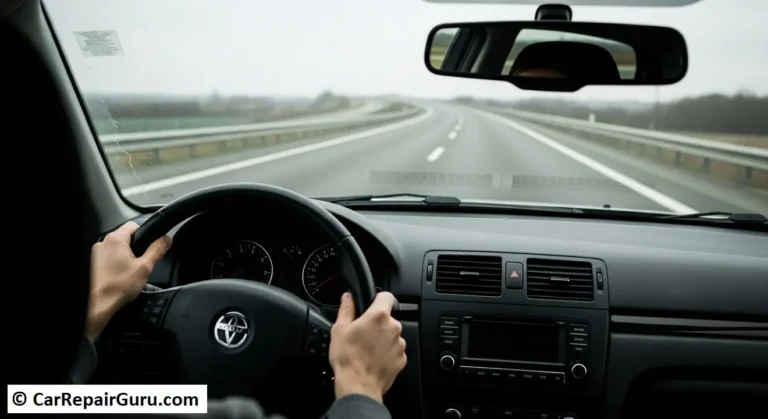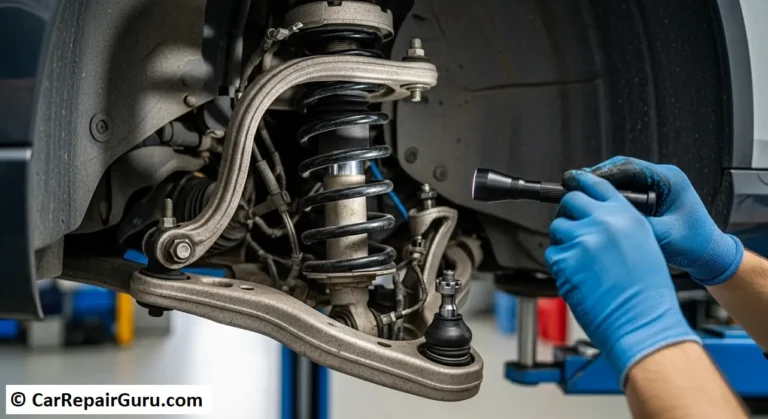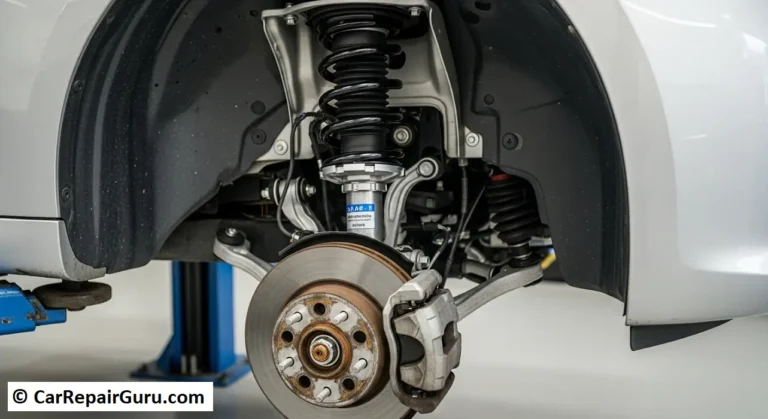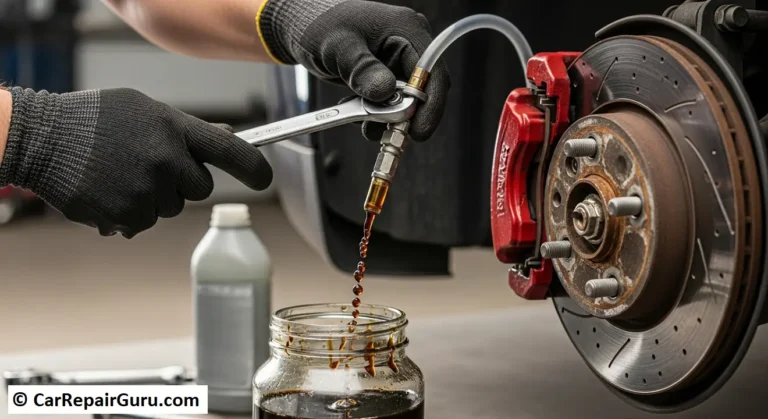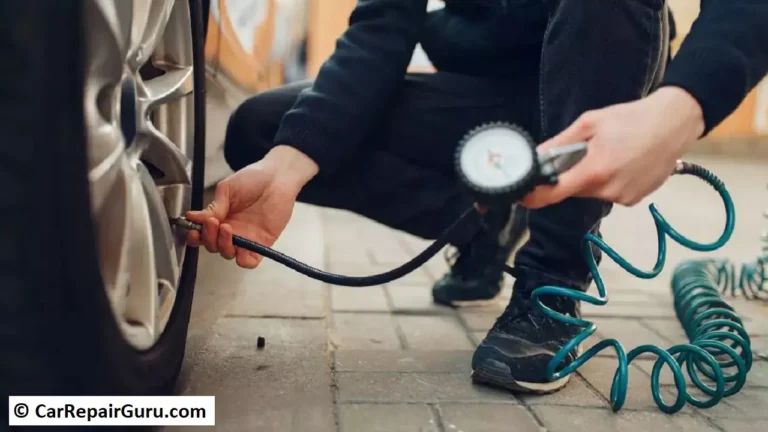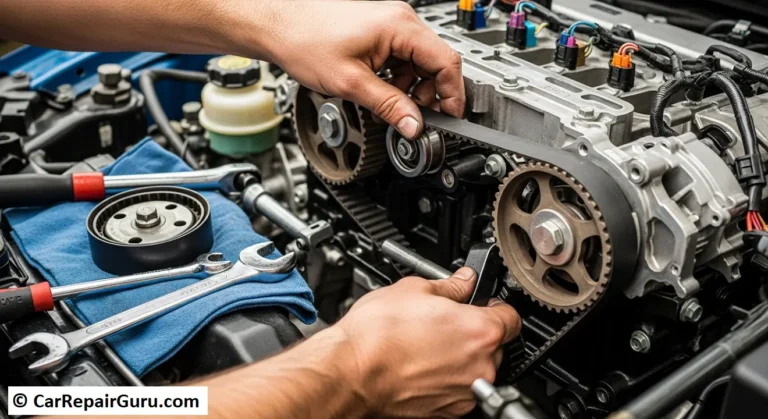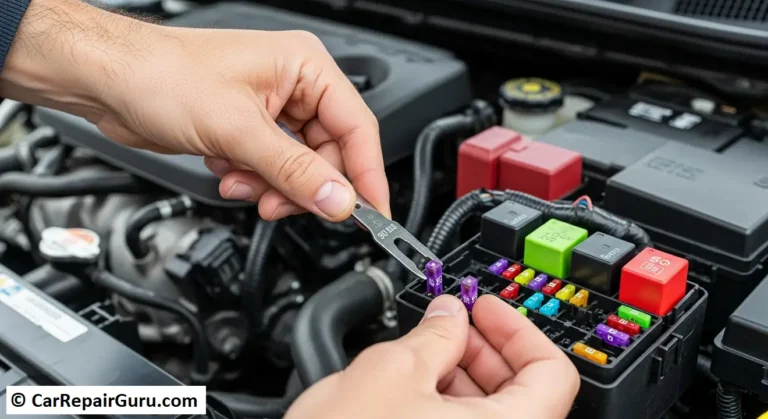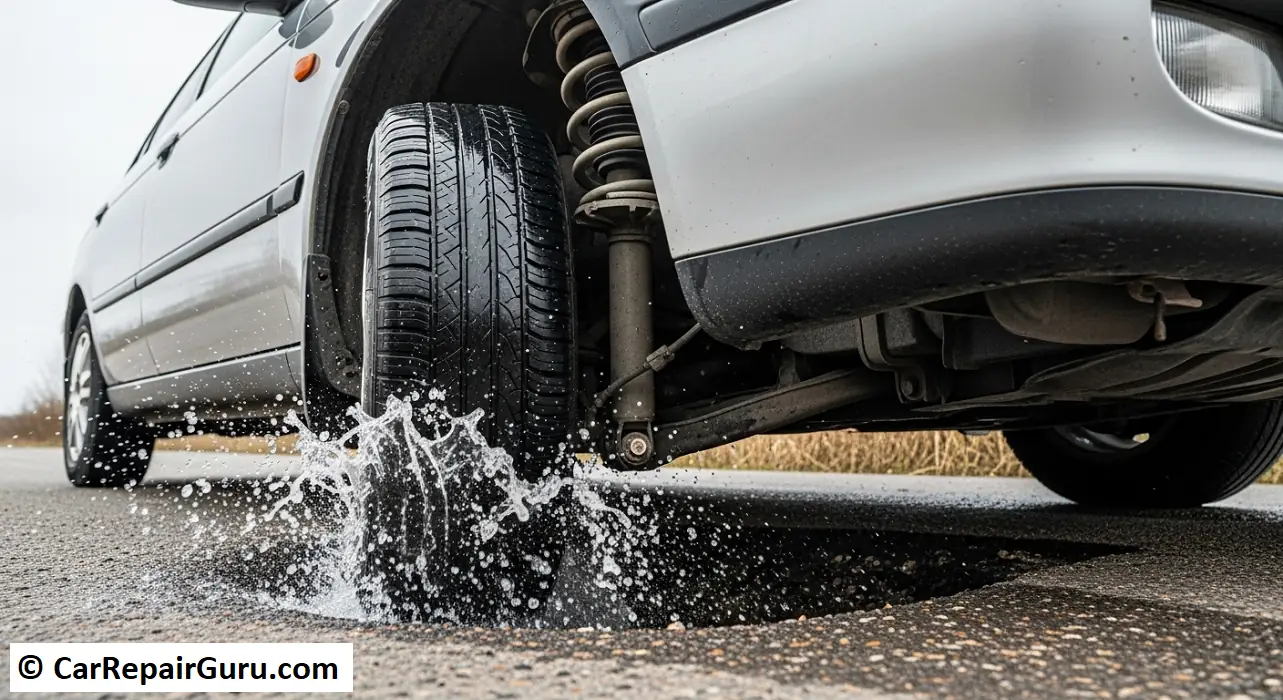
Ever hit a pothole and felt a jarring thud, followed by a bit of unsettling bouncing? Or maybe you’ve taken a turn and felt your car lean more than you were comfortable with. We often think of our car’s suspension as the system that keeps the ride smooth and comfortable. While that’s true, its most important job is far more critical. Your suspension is the unsung hero of vehicle safety and performance.
The suspension impact on your daily drive is immense. It’s the crucial link between your car and the road, dictating everything from how quickly you can stop in an emergency to how well you can steer out of harm’s way. This article will explore the direct link between your suspension’s health and three key areas: your safety on the road, your car’s handling and performance, and your overall control as a driver.
What is a Vehicle Suspension System? A Quick Primer
So, what exactly is this system doing under your car? In simple terms, a vehicle suspension system has two main goals:
- Maximize Grip: It works constantly to keep your tires pressed firmly against the road, maximizing friction (or grip). No grip means no control.
- Provide Stability & Comfort: It absorbs bumps and vibrations from the road surface, giving you and your passengers a stable, comfortable ride.
To do this, it uses a team of components working in harmony.
Key Components You Should Know –
- Springs (Coil, Leaf, or Torsion): These are the workhorses that hold up the vehicle’s weight. When you hit a bump, the spring compresses to absorb the initial impact.
- Shock Absorbers (or Dampers): A spring on its own would just keep bouncing like a pogo stick. Shock absorbers control, or “dampen,” this unwanted bouncing motion, forcing the tire back onto the road quickly and keeping the car stable.
- Struts: A strut is a clever, all-in-one assembly that combines the shock absorber and the spring into a single structural unit. Most modern passenger cars use struts in the front.
- Control Arms & Bushings: These are the pivot points and connections that attach the suspension components to the vehicle’s frame, allowing the wheels to move up and down independently.
The Critical Suspension Impact on Vehicle Safety
This is where ignoring your suspension can become dangerous. A healthy suspension is a core safety feature, just as important as your brakes or airbags. When it’s worn, it compromises your car’s ability to react in critical situations.
Braking Distance and Control (Nose-Diving)
Have you ever slammed on the brakes and felt the front end of your car dip forward aggressively? This is called “nose-diving,” and it’s a classic sign of worn shocks or struts. When this happens, the vehicle’s weight shifts violently to the front tires. This imbalance can unsettle the car and significantly increase braking distance—in some cases by up to 20%. That extra distance could be the difference between a close call and a collision.
Stability in Turns and Evasive Maneuvers (Body Roll)
When you steer into a corner, your car’s momentum wants to keep it going straight. This force causes the car’s body to lean, or “roll,” toward the outside of the turn. A healthy suspension system counteracts this body roll, keeping the car more level and all four tires planted firmly on the pavement. If your suspension is worn, this roll becomes excessive, making the car feel unstable and “wallowy.” In an emergency swerve to avoid an obstacle, this loss of stability could lead to a complete loss of control or even a rollover.
Maintaining Tire Contact with the Road (Traction)
This is the most fundamental job of your suspension. Over any uneven surface—be it a bump, a dip, or a rough patch of road—a worn suspension allows the tire to bounce. For that split second the tire is in the air, you have zero traction. You can’t steer, you can’t brake, and you can’t accelerate. While it might just feel like a bumpy ride on a dry day, this loss of road grip is incredibly dangerous in wet, icy, or slippery conditions, where maintaining constant tire contact is paramount.
How Suspension Dictates Vehicle Performance and Handling
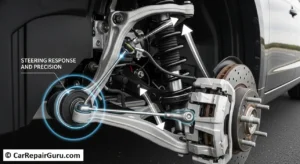
Beyond the critical safety aspects, the suspension’s effect on your car’s overall performance and driving feel is profound. It’s the difference between a car that feels connected and responsive versus one that feels vague and disconnected from the road.
Steering Response and Precision
Think of your steering wheel as a set of instructions and your suspension as the messenger. With a firm, healthy suspension, your steering inputs are translated instantly and precisely to the tires. The car goes exactly where you point it, when you point it there. A worn suspension, with its tired bushings and weak shocks, creates a “slop” in the system. Your steering feels less direct, and the car is slower to respond, robbing you of driver confidence.
Enhancing Ride Comfort
This is the benefit everyone notices. The suspension’s ability to absorb road imperfections is what creates a smooth ride. It isolates the vehicle’s cabin from harshness, noise, and vibration. A failing system will pass every crack and bump directly on to you and your passengers, making for a fatiguing and unpleasant journey.
Acceleration Control (Anti-Squat)
Just as worn shocks cause nose-diving during braking, they also cause the rear of the car to “squat” down during hard acceleration. This motion shifts weight off the front wheels (which are the drive wheels in most passenger cars), potentially reducing traction and hampering performance right when you need it most.
How Driving Habits and Environment Affect Your Suspension
Your suspension doesn’t wear out in a vacuum. How and where you drive play a massive role in its lifespan. Being mindful of these factors can save you money and keep your car safer for longer.
The #1 Enemy – Potholes and Rough Roads
Hitting a sharp-edged pothole at speed is one of the worst things for your car’s suspension. This sudden, violent impact can bend rims, damage tires, and send a shockwave through your suspension components. It can bend control arms or blow the seals on a shock absorber. The best defense is to stay alert, slow down for speed bumps and rough patches, and safely navigate around potholes whenever possible.
The Strain of Heavy Loads (Towing & Hauling)
If you frequently use your vehicle for towing or hauling heavy materials, you’re putting your stock suspension under constant, significant stress. This extra weight can cause the springs to fatigue and sag over time and will wear out the shock absorbers much faster. If this is a regular activity, looking into heavy-duty suspension or helper springs might be a wise investment.
Aggressive vs. Defensive Driving Style
Your driving style has a direct effect on your suspension. Aggressive driving—with hard cornering, sudden braking, and rapid acceleration—forces the suspension to work at its limits constantly. This repeated, stressful movement accelerates wear on every single component. In contrast, a smooth, defensive driving style minimizes stress and can significantly prolong component life.
Environmental Factors – Salt, Grime, and Corrosion
For those in colder climates, road salt is a major enemy. It can cause severe rust and corrosion on metal suspension parts, seizing bolts and weakening components like springs and control arms. Dirt and grime can also work their way into joints and bushings, acting like sandpaper and accelerating wear. A simple but effective defense is to give your car’s undercarriage a thorough wash periodically, especially after the winter season.
7 Warning Signs Your Suspension Needs Attention
Your car is excellent at telling you when something is wrong—you just need to know what to look and listen for. If you notice any of these signs, it’s time to get it inspected.
- A Bouncy, Unstable Ride: This is the classic symptom. After hitting a bump, your car continues to bounce up and down instead of settling immediately.
- Excessive Nose-Diving or Body Roll: The car dips forward dramatically when you brake or leans heavily in turns.
- Visible Fluid Leaks: Take a look at your shocks and struts. If they look oily or greasy, the seals have likely failed, and they are no longer functioning correctly.
- Uneven Tire Wear: A bad suspension can cause a strange wear pattern on your tires called “cupping” or “scalloping,” which looks like dips or hollows in the tread.
- The “Bounce Test” Fails: Go to one corner of your parked car and push down firmly on the bumper a few times. When you let go, the car should rebound once and settle. If it bounces two, three, or more times, the shock or strut on that corner is likely worn out.
- Clunking or Knocking Noises: Strange noises, especially when going over bumps or turning, often point to worn-out bushings, ball joints, or shock mounts.
- Vehicle Pulls to One Side: While often a sign of a bad wheel alignment, a worn-out spring or strut can also cause the vehicle’s ride height to be off on one side, making it pull.
Stock vs. Aftermarket – Choosing the Right Suspension Upgrade
For some drivers, simply replacing worn parts with factory-equivalents is perfect. But for others, a failing suspension presents an opportunity. If you’re looking for more performance, capability, or a different look, the world of aftermarket suspension awaits.
Understanding OEM (Stock) Suspension
The Original Equipment Manufacturer (OEM) suspension on your car is a masterpiece of compromise. Engineers designed it to provide a good balance of comfort, durability, and quiet operation for the average driver. For the vast majority of people, it’s the perfect setup.
When to Consider an Aftermarket Upgrade
You might want to explore aftermarket options if your needs go beyond the daily commute. Common reasons include:
- Enhanced Performance: For drivers who want sharper handling and a more “connected” feel.
- Towing/Hauling: Needing heavy-duty components that won’t sag under extra weight.
- Off-Roading: Requiring more ground clearance and durability for rough terrain.
- Aesthetics: Achieving a specific look by either lowering or lifting the vehicle.
Common Types of Suspension Upgrades
- Sport Suspension: Typically involves installing stiffer, shorter springs and matching sport-tuned shocks. This lowers the car’s center of gravity for a dramatic improvement in handling.
- Coilovers: These are popular with enthusiasts. Coilovers are integrated shock-and-spring units that offer adjustable ride height and, in many cases, adjustable damping.
- Lifting Kits: A must-have for serious off-roaders, lift kits increase the vehicle’s ride height for greater ground clearance and larger tires.
- Air Suspension (Air Ride): The ultimate in adjustability. Air suspension replaces steel springs with durable airbags, allowing you to change the vehicle’s height with the push of a button.
The Risks of Ignoring a Bad Suspension

Putting off a needed suspension repair isn’t just a comfort issue; it’s a risk to your wallet and your well-being.
Compromised Safety
As we’ve covered, the safety risks are real. You’re driving a vehicle with a longer braking distance, reduced stability in corners, and less control during an emergency maneuver. You are fundamentally less equipped to avoid an accident.
Increased Long-Term Costs
A failing suspension creates a domino effect of damage. The constant bouncing and vibration cause premature wear on many other parts. Your tires will wear out much faster. Your wheel bearings, ball joints, and tie rod ends will be subjected to impacts they weren’t designed to handle, leading to more expensive repairs down the road.
Your Suspension is Your Connection to the Road
Your vehicle’s suspension system is far more than a luxury; it’s a fundamental pillar of the safety, performance, and comfort triangle. The suspension impact is felt every time you turn, brake, or accelerate. It’s your car’s first and last line of defense against road imperfections and your primary tool for maintaining control when it matters most.
Paying attention to the warning signs and investing in timely maintenance or repair is an investment in your safety, the safety of your passengers, and the longevity of your entire vehicle.
Don’t wait until it’s too late. Noticed any of these signs? Schedule a professional suspension inspection with a certified technician today to ensure your vehicle is safe and performing at its best!
Frequently Asked Questions
Is it safe to drive with a bad suspension?
It is strongly not recommended. While the car will still drive, your ability to control it, especially in an emergency, is significantly reduced. Your braking and steering systems cannot work effectively if the tires aren’t kept firmly on the road.
What is the difference between shocks and struts?
They both do the same job of damping spring movement, but a strut is also a structural part of the suspension. It replaces the upper control arm and serves as a pivot point for the steering system. Shocks are simply dampers and are not integrated into the vehicle’s structure in the same way.
How often should I get my suspension checked?
A good rule of thumb is to have your suspension visually inspected by a professional at least once a year or every 12,000 miles. You should have it checked immediately if you notice any of the warning signs.
How much does suspension repair cost?
The cost varies widely. Replacing a pair of rear shocks might cost a few hundred dollars, while replacing a full set of four struts on a modern car could cost well over a thousand dollars, depending on the vehicle and labor rates.
